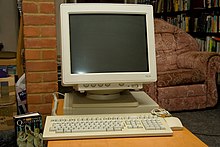

In computing, an X terminal is a display/input terminal for X Window System client applications. X terminals enjoyed a period of popularity in the early 1990s when they offered a lower total cost of ownership alternative to a full Unix workstation.
An X terminal runs an 'X server'. In X, the usage of "client" and "server" is from the viewpoint of the programs: the X server supplies a screen, keyboard, mouse and touchscreen to client applications. This connects to an X display manager (introduced in X11R3) running on a central machine, using XDMCP (X Display Manager Control Protocol, introduced in X11R4).
Thin clients have somewhat supplanted X terminals in that they are equipped with added flash memory and software for communication with remote desktop protocols.
Vendors
In the early 1990s, several vendors introduced X terminals including HP, DEC (including the VT1000 series), IBM, Samsung, NCD, Gipsi, Tektronix, and Visual Technology.
See also
References
- Mui, Linda; Pearce, Eric (July 1993), X Window System (softcover), vol. 8: X Window System Administrator's Guide for X11 Release 4 and Release 5 (3rd ed.), O'Reilly & Associates, ISBN 0-937175-83-8.
- InfoWorld, 28 May 1990.
- Corcoran, Cate (1992). "Study shows 115 percent increase in X terminal sales for 1991". InfoWorld. 14 (3): 26.
Network Computing Devices dominated the market... NCD, HP, Digital Equipment Corporation, IBM and Tektronix – the top five X terminal vendors – accounted for 74 percent of shipments...
- Staff writer (August 7, 1989). "Visual Technology Files for Chapter 11 Bankruptcy, but Readies New X Terminals". Computer Business Review. New Statesman Media Group. Archived from the original on February 26, 2024.
| X Window System | |||||||||||||||
|---|---|---|---|---|---|---|---|---|---|---|---|---|---|---|---|
| Architecture |  | ||||||||||||||
| Extensions | |||||||||||||||
| Components and notable implementations |
| ||||||||||||||
| Standards | |||||||||||||||
| Applications | |||||||||||||||
This computer hardware article is a stub. You can help Misplaced Pages by expanding it. |
This computer networking article is a stub. You can help Misplaced Pages by expanding it. |